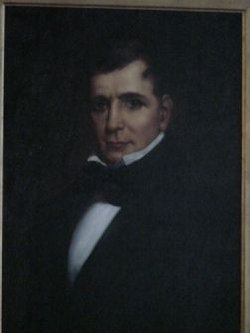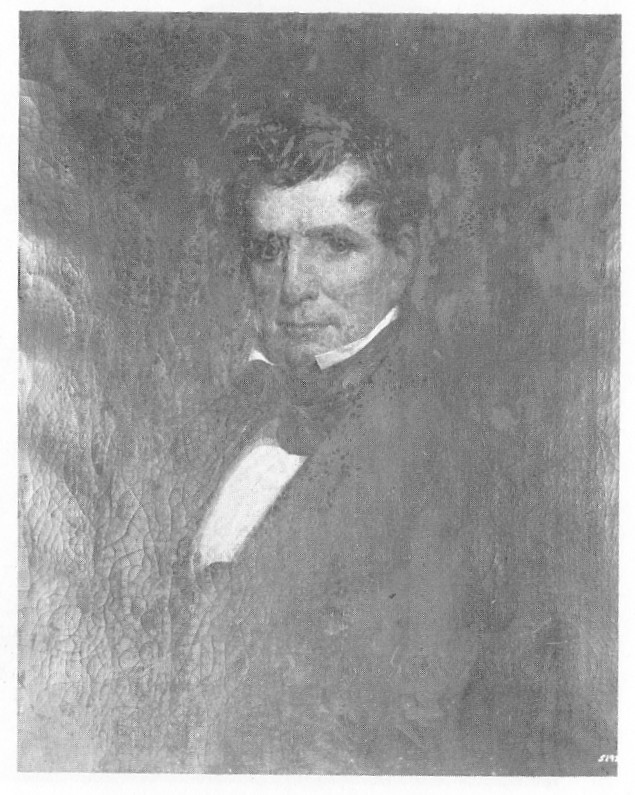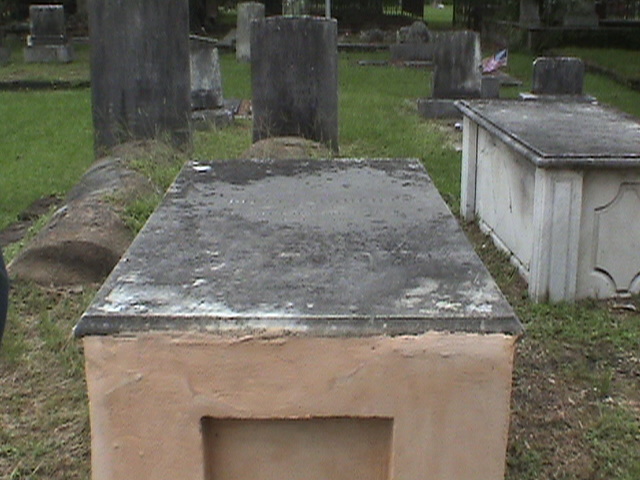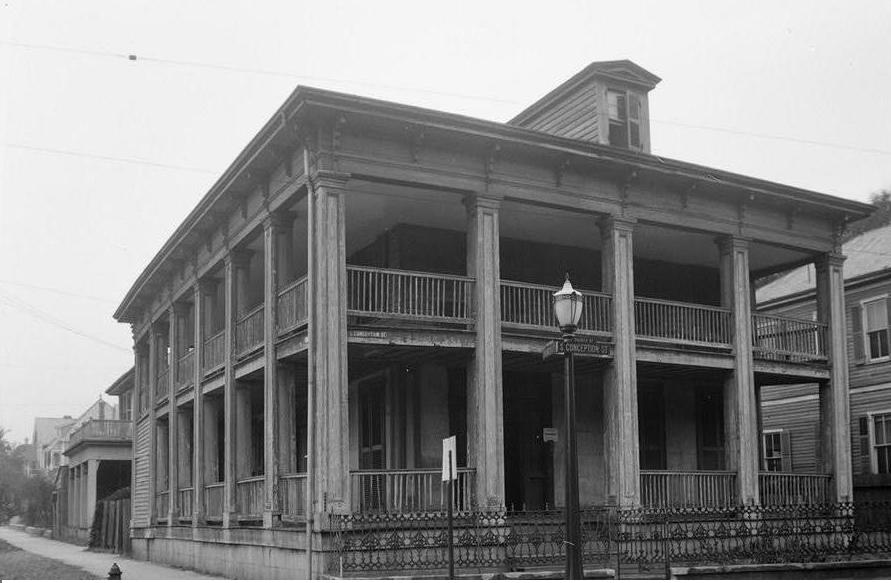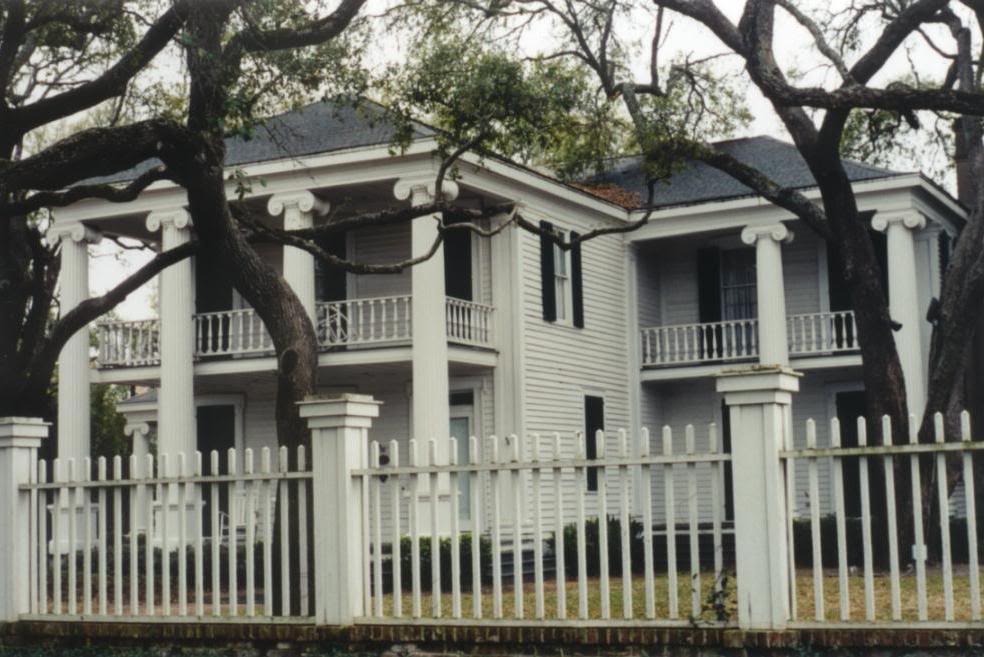Helped select and establish the first state capital at Cahawba, 1819.
Founder of the Mobile Chronicle, 1827.
First superintendent of the Mobile City Hospital, 1830.
Dr. Willis Roberts was a son of Thomas Roberts and Mary Herndon and a grandson of George Herndon of Orange County, North Carolina. His parents moved from South Carolina to Georgia by 1789. He married in Warren County, Georgia, Feb. 20, 1801, Asenath Alexander, moved to Cahawba, Alabama, in 1819, and to Mobile around 1824. He was a former judge of inferior court in Putnam Co., Georgia, when Gov. William Rabun commissioned him as navigator and cartographer in 1818 "to examine the navigable waterways and report on the practicability of improvement and estimate of the expense to do so." Beginning at Fort Hawkins, he followed the Ocmulgee River to its junction with the Oconee River before he had to resign due to illness.
He became the personal secretary of Alabama's first governor, Dr. William Wyatt Bibb, an 1801 graduate of the Medical College of the University of Pennsylvania. Three months into his term, the governor was thrown from his horse and killed, and succeeded by his brother Thomas Bibb, whose wife Parmelia Thompson Bibb was Willis Roberts' cousin. Willis Roberts was a member of the three-man committee which selected Cahawba as the site of the first state capital of Alabama (MOBILE REGISTER, Jan. 3, 1920). He and Benjamin Clements designed, platted and laid out the town "modeled on the city of Philadelphia" (THREE CAPITALS by William Henderson Brantley, 1947, p. 63; Alabama Historical Quarterly, XXXI p.164). He was appointed one of three managers of the first election held at Cahawba on Dec. 3, 1819 (Alabama, Her History, 1872, by Willis Brewer, p. 209; Hist. of Alabama & Dictionary of Alabama Biography, p. 716; Gould's History of Freemasonry Throughout the World, by Robert F. Gould, 1936, Vol. 5, p. 4; Memories of Old Cahaba (1905) by Anna M. Gayle Fry, p. 11).
On Feb. 14, 1818, Gov. Bibb appointed Willis Roberts the first clerk of superior court and clerk of Dallas County courts (Hist. of Alabama by Thomas M. & Marie Bankhead Owen, vol. 1, p. 447).
He is referred to as a candidate for Secretary of State, 1818 (ref., The Political Graveyard).
He was nominated in the election for first State Treasurer of Alabama but on Nov. 23, 1820, lost by 22 votes in both the house and senate to Jack Ferrill Ross. He was nominated for state treasurer again in the next election but withdrew his name on Nov. 8, 1821, when none of the three candidates received a constitutional majority, after which John C. Perry won the election. On Dec. 23, 1823, Dr. Roberts and Henry Hitchcock were among 24 nominees for twelve positions for directors of the State Bank of Alabama. Willis Roberts lost the election to Horatio G. Perry while Hitchcock won his. Dr. Roberts' son Joel Abbot Roberts became a director of the Alabama State Bank in later years.
Dr. Roberts was partner in a mercantile store with James Battle known as Battle and Roberts, was afterwards a partner with Mirabeau Lamar, later President of the Republic of Texas, and who lived in the Roberts household both at Cahawba and at various times later in Mobile. Lamar described life in Cahawba: "There was not another community more representative of the South's best culture than this new capital. No people in all America sat down to more bounteous dinners, served by better servants on richer mahogany. No people rode better groomed horses, or spoke their vernacular with gentler accents."
After the failure of Roberts & Lamar, Willis Roberts moved to Mobile as did so many of his friends and neighbors, such as Battle, Ross, and Hitchcock. Some accounts place the Roberts move to Mobile as early as 1824; Notable Men of Alabama says 1827; apparently they were back and forth for some period. They were also in Pennsylvania in 1824 when their last child, Seth Willis Roberts, was born, and the eldest son, Samuel Alexander, started at West Point. Dr. Roberts owned the City Hotel in Mobile which burned to the ground on Oct. 21, 1827. The rebuilt hotel was later burned down by the notorious Copeland Gang, when they looted the city, on Oct. 2, 1839.
In 1828, Dr. Roberts drew an early map of Spring Hill which is mentioned in several Mobile histories and cited in numerous deeds recorded as recently as the 1980s, "still considered the most authoritative" map of the area according to some sources. He platted the land for William H. Robertson, the owner who subdivided and sold most of Spring Hill. Originally called Summerville, the higher ground of the western suburbs had been a popular getaway for Mobilians since the earliest days.
Willis Roberts also founded the Mobile Chronicle and offered editorship position to Mirabeau Lamar who declined it (ref., Houston Telegraph, June 23, 1838, p. 3).
He was the first superintendent of the Mobile City Hospital in 1830. He served on the building committee which planned, secured funding, and selected the architects for the city hospital as well as Barton Academy, Alabama's first public school, two of the grand Greek Revival public buildings erected during Mobile's flush times of the 1830s that still stand today and upon which Mobile's reputation for fine architecture was founded. Barton Academy's dome was an architectural marvel in its day, predating the domes of the state capitol in Montgomery and the U.S. capitol in Washington, D.C., by two and three decades respectively. Dr. Roberts probably served on the building committee of the two churches he attended, the Government Street Presbyterian Church and Christ Episcopal Church which was the first home of the Presbyterian congregation. The building records of both churches are incomplete, but from the style, quality, and ambitious scale of the architecture, it is more than probable that Willis Roberts was involved to some degree in the construction of both.
In 1835 Dr. Roberts' son, Samuel Alexander Roberts, represented Mobile County in the state legislature. By 1837 Mirabeau Lamar was encouraging him to move to Texas. Lamar asked all the Roberts family to come to the new country when he became vice president and afterwards president of the Republic of Texas. Dr. Roberts and most of his family left Mobile for a brief, ill-fated Texas adventure at that time. Lamar had ambitions to expand the new nation of Texas as far as the west coast of California, and Dr. Roberts' son-in-law Palmer Pillans was actively involved in the annexation plans, going as far as New Mexico where he was appointed first chief justice of the New Mexico Supreme Court. President Lamar made several appointments to Willis and his sons.
Dr. Roberts found Texas trees smaller and less satisfactory for construction, so with characteristic optimism, he shipped from Mobile in May 1838 a great house frame of native timber, intending to construct a mansion like Texas had never seen before. The giant house frame was trekked over half the Texas frontier before a suitable location for it was finally chosen: Aransas City on Live Oak Point, in Aransas County. Dr. Roberts and his sons Joel and Reuben oversaw the construction. The mansion had been finished only a few months when President Lamar appointed Willis Roberts the Collector of Customs for the Port of Galveston, 250 miles away. The appointment lasted from December 1838 to December 1839. So less than six months after finishing what may have been the grandest mansion in Texas, Dr. Roberts moved to Galveston and began building another residence of ambitious scale. The records are unclear as to whether the second house frame also came from Mobile, but it is likely that it did. This second Texas house dominated Galveston's East Square for nearly a century, surviving the hurricane of 1900 and was said to have been standing in the 1930s but demolished sometime thereafter. It was "afterward the residence of John Price, and subsequently owned by Mr. Winnee." (Galveston: History of the Island and the City (1879), by Charles W. Hayes, Volume 1, p.130, 275.) John Price resided in Galveston before 1846 and Gilbert Winnie was a city alderman in 1854. A Galveston researcher described it as closely resembling Michel B. Menard's 1838 home, said to be the oldest house standing in Galveston today.
Willis Roberts' appointment at Galveston had caused some local resentment. Gail Borden, Jr., later known as the inventor of condensed milk, served as the Port of Galveston Customs Collector from 1837 to December 1838, when Lamar removed him and appointed Roberts to the office. Later Governor Lubbock wrote: "Gail Borden, the very able and popular old Texan, collector of the port of Galveston, was removed for similar reasons and his office given to a very elegant old gentleman, a Mr. Roberts, but very recently from Alabama. He was the father of one of our most distinguished lawyers, Sam Roberts, of North Texas." (Six decades in Texas; or, Memoirs of Francis Richard Lubbock (1900), p. 98; 1968 edition, p.93.)
Further trouble for the port collector surfaced after subordinates in the Galveston office mismanaged funds, for which Dr. Roberts offered his own property as collateral until the matter could be resolved. He was succeeded by Alden A. M. Jackson as customs collector in December 1839 and then returned to Mobile, a place with happier memories.
THE TEXAS THAT MIGHT HAVE BEEN, by Albert Sidney Johnston, Margaret S. Henson, Donald E. Willett (2009), p. 66: "A later government investigation determined that two clerks, not Dr. Roberts, stole from the government."
Dr. Willis Roberts continued to take an active interest in Mobile's economic, civic, and social life, and in new construction, and while at an age that most men slow down, he resumed his private medical practice in a small building still standing at the northeast corner of Government and Saint Emanuel streets. He worked ceaselessly during the 1853 yellow fever epidemic and continued working until the day of his last illness from which he never recovered. He was buried on Christmas Eve.
ADDITIONAL CHILDREN OF DR. WILLIS ROBERTS & ASENATH ALEXANDER:
SAMUEL ALEXANDER ROBERTS (1809-1872)
SOPHIA LOWRY (ROBERTS) SETTLE, Mrs. John A. Settle, B. January 09, 1813 GA
d. April 02, 1878 San Antonio, Bexar Co., AL
Burial location: Texas
EMILY ROGERS ROBERTS (1816-1833)
Helped select and establish the first state capital at Cahawba, 1819.
Founder of the Mobile Chronicle, 1827.
First superintendent of the Mobile City Hospital, 1830.
Dr. Willis Roberts was a son of Thomas Roberts and Mary Herndon and a grandson of George Herndon of Orange County, North Carolina. His parents moved from South Carolina to Georgia by 1789. He married in Warren County, Georgia, Feb. 20, 1801, Asenath Alexander, moved to Cahawba, Alabama, in 1819, and to Mobile around 1824. He was a former judge of inferior court in Putnam Co., Georgia, when Gov. William Rabun commissioned him as navigator and cartographer in 1818 "to examine the navigable waterways and report on the practicability of improvement and estimate of the expense to do so." Beginning at Fort Hawkins, he followed the Ocmulgee River to its junction with the Oconee River before he had to resign due to illness.
He became the personal secretary of Alabama's first governor, Dr. William Wyatt Bibb, an 1801 graduate of the Medical College of the University of Pennsylvania. Three months into his term, the governor was thrown from his horse and killed, and succeeded by his brother Thomas Bibb, whose wife Parmelia Thompson Bibb was Willis Roberts' cousin. Willis Roberts was a member of the three-man committee which selected Cahawba as the site of the first state capital of Alabama (MOBILE REGISTER, Jan. 3, 1920). He and Benjamin Clements designed, platted and laid out the town "modeled on the city of Philadelphia" (THREE CAPITALS by William Henderson Brantley, 1947, p. 63; Alabama Historical Quarterly, XXXI p.164). He was appointed one of three managers of the first election held at Cahawba on Dec. 3, 1819 (Alabama, Her History, 1872, by Willis Brewer, p. 209; Hist. of Alabama & Dictionary of Alabama Biography, p. 716; Gould's History of Freemasonry Throughout the World, by Robert F. Gould, 1936, Vol. 5, p. 4; Memories of Old Cahaba (1905) by Anna M. Gayle Fry, p. 11).
On Feb. 14, 1818, Gov. Bibb appointed Willis Roberts the first clerk of superior court and clerk of Dallas County courts (Hist. of Alabama by Thomas M. & Marie Bankhead Owen, vol. 1, p. 447).
He is referred to as a candidate for Secretary of State, 1818 (ref., The Political Graveyard).
He was nominated in the election for first State Treasurer of Alabama but on Nov. 23, 1820, lost by 22 votes in both the house and senate to Jack Ferrill Ross. He was nominated for state treasurer again in the next election but withdrew his name on Nov. 8, 1821, when none of the three candidates received a constitutional majority, after which John C. Perry won the election. On Dec. 23, 1823, Dr. Roberts and Henry Hitchcock were among 24 nominees for twelve positions for directors of the State Bank of Alabama. Willis Roberts lost the election to Horatio G. Perry while Hitchcock won his. Dr. Roberts' son Joel Abbot Roberts became a director of the Alabama State Bank in later years.
Dr. Roberts was partner in a mercantile store with James Battle known as Battle and Roberts, was afterwards a partner with Mirabeau Lamar, later President of the Republic of Texas, and who lived in the Roberts household both at Cahawba and at various times later in Mobile. Lamar described life in Cahawba: "There was not another community more representative of the South's best culture than this new capital. No people in all America sat down to more bounteous dinners, served by better servants on richer mahogany. No people rode better groomed horses, or spoke their vernacular with gentler accents."
After the failure of Roberts & Lamar, Willis Roberts moved to Mobile as did so many of his friends and neighbors, such as Battle, Ross, and Hitchcock. Some accounts place the Roberts move to Mobile as early as 1824; Notable Men of Alabama says 1827; apparently they were back and forth for some period. They were also in Pennsylvania in 1824 when their last child, Seth Willis Roberts, was born, and the eldest son, Samuel Alexander, started at West Point. Dr. Roberts owned the City Hotel in Mobile which burned to the ground on Oct. 21, 1827. The rebuilt hotel was later burned down by the notorious Copeland Gang, when they looted the city, on Oct. 2, 1839.
In 1828, Dr. Roberts drew an early map of Spring Hill which is mentioned in several Mobile histories and cited in numerous deeds recorded as recently as the 1980s, "still considered the most authoritative" map of the area according to some sources. He platted the land for William H. Robertson, the owner who subdivided and sold most of Spring Hill. Originally called Summerville, the higher ground of the western suburbs had been a popular getaway for Mobilians since the earliest days.
Willis Roberts also founded the Mobile Chronicle and offered editorship position to Mirabeau Lamar who declined it (ref., Houston Telegraph, June 23, 1838, p. 3).
He was the first superintendent of the Mobile City Hospital in 1830. He served on the building committee which planned, secured funding, and selected the architects for the city hospital as well as Barton Academy, Alabama's first public school, two of the grand Greek Revival public buildings erected during Mobile's flush times of the 1830s that still stand today and upon which Mobile's reputation for fine architecture was founded. Barton Academy's dome was an architectural marvel in its day, predating the domes of the state capitol in Montgomery and the U.S. capitol in Washington, D.C., by two and three decades respectively. Dr. Roberts probably served on the building committee of the two churches he attended, the Government Street Presbyterian Church and Christ Episcopal Church which was the first home of the Presbyterian congregation. The building records of both churches are incomplete, but from the style, quality, and ambitious scale of the architecture, it is more than probable that Willis Roberts was involved to some degree in the construction of both.
In 1835 Dr. Roberts' son, Samuel Alexander Roberts, represented Mobile County in the state legislature. By 1837 Mirabeau Lamar was encouraging him to move to Texas. Lamar asked all the Roberts family to come to the new country when he became vice president and afterwards president of the Republic of Texas. Dr. Roberts and most of his family left Mobile for a brief, ill-fated Texas adventure at that time. Lamar had ambitions to expand the new nation of Texas as far as the west coast of California, and Dr. Roberts' son-in-law Palmer Pillans was actively involved in the annexation plans, going as far as New Mexico where he was appointed first chief justice of the New Mexico Supreme Court. President Lamar made several appointments to Willis and his sons.
Dr. Roberts found Texas trees smaller and less satisfactory for construction, so with characteristic optimism, he shipped from Mobile in May 1838 a great house frame of native timber, intending to construct a mansion like Texas had never seen before. The giant house frame was trekked over half the Texas frontier before a suitable location for it was finally chosen: Aransas City on Live Oak Point, in Aransas County. Dr. Roberts and his sons Joel and Reuben oversaw the construction. The mansion had been finished only a few months when President Lamar appointed Willis Roberts the Collector of Customs for the Port of Galveston, 250 miles away. The appointment lasted from December 1838 to December 1839. So less than six months after finishing what may have been the grandest mansion in Texas, Dr. Roberts moved to Galveston and began building another residence of ambitious scale. The records are unclear as to whether the second house frame also came from Mobile, but it is likely that it did. This second Texas house dominated Galveston's East Square for nearly a century, surviving the hurricane of 1900 and was said to have been standing in the 1930s but demolished sometime thereafter. It was "afterward the residence of John Price, and subsequently owned by Mr. Winnee." (Galveston: History of the Island and the City (1879), by Charles W. Hayes, Volume 1, p.130, 275.) John Price resided in Galveston before 1846 and Gilbert Winnie was a city alderman in 1854. A Galveston researcher described it as closely resembling Michel B. Menard's 1838 home, said to be the oldest house standing in Galveston today.
Willis Roberts' appointment at Galveston had caused some local resentment. Gail Borden, Jr., later known as the inventor of condensed milk, served as the Port of Galveston Customs Collector from 1837 to December 1838, when Lamar removed him and appointed Roberts to the office. Later Governor Lubbock wrote: "Gail Borden, the very able and popular old Texan, collector of the port of Galveston, was removed for similar reasons and his office given to a very elegant old gentleman, a Mr. Roberts, but very recently from Alabama. He was the father of one of our most distinguished lawyers, Sam Roberts, of North Texas." (Six decades in Texas; or, Memoirs of Francis Richard Lubbock (1900), p. 98; 1968 edition, p.93.)
Further trouble for the port collector surfaced after subordinates in the Galveston office mismanaged funds, for which Dr. Roberts offered his own property as collateral until the matter could be resolved. He was succeeded by Alden A. M. Jackson as customs collector in December 1839 and then returned to Mobile, a place with happier memories.
THE TEXAS THAT MIGHT HAVE BEEN, by Albert Sidney Johnston, Margaret S. Henson, Donald E. Willett (2009), p. 66: "A later government investigation determined that two clerks, not Dr. Roberts, stole from the government."
Dr. Willis Roberts continued to take an active interest in Mobile's economic, civic, and social life, and in new construction, and while at an age that most men slow down, he resumed his private medical practice in a small building still standing at the northeast corner of Government and Saint Emanuel streets. He worked ceaselessly during the 1853 yellow fever epidemic and continued working until the day of his last illness from which he never recovered. He was buried on Christmas Eve.
ADDITIONAL CHILDREN OF DR. WILLIS ROBERTS & ASENATH ALEXANDER:
SAMUEL ALEXANDER ROBERTS (1809-1872)
SOPHIA LOWRY (ROBERTS) SETTLE, Mrs. John A. Settle, B. January 09, 1813 GA
d. April 02, 1878 San Antonio, Bexar Co., AL
Burial location: Texas
EMILY ROGERS ROBERTS (1816-1833)
Bio by: Ray Isbell
Inscription
IN
Memory of
WILLIS ROBERTS
who died
the 23rd December 1853,
aged 74 years.
Family Members
-
![]()
Olivea A. Roberts Mather
1804–1882
-
Mary Herndon Roberts
1806–1822
-
![]()
BG Samuel Alexander Roberts
1809–1872
-
![]()
Joel Abbot Roberts
1811–1863
-
![]()
Sophia Lowry "Sophy" Roberts Settle
1813–1878
-
![]()
Emily R. Roberts
1816–1833
-
![]()
Reuben Herndon Roberts
1817–1884
-
![]()
Laura Malvina Roberts Pillans
1819–1883
-
Willis Roberts Jr
1822–1823
-
Seth Willis Roberts
1823–1880
Advertisement
Records on Ancestry
Sponsored by Ancestry
Advertisement
